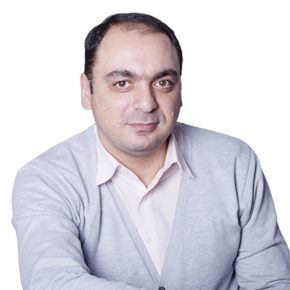By an unexpected coincidence the group of Armenian journalists appeared in Tallinn during the historical period of alternation in power in Estonia. Personally, I learned about it only on the second day and quite accidentally; at one of the meetings our interlocutor apologized for having to leave early as Prime Minister elections were being held in their country. By the way, the Estonian PM is only 34 and the majority of ministers are barely 40; besides, 5 out of 13 ministers are women. We didn’t manage to meet the newly-appointed PM but I am more than convinced had we stayed in Tallinn for 2-3 more days we would beyond doubt meet him – in Estonia the PM and the ministers have a meeting with journalists at least once a week, as a rule on Tuesday at the end of the governmental sitting. By the way, there is no accreditation – the country is small and all people know each other.
Presently, Estonia is a full EU and NATO member state with EUR 1000 average salary, EUR 400 average pension and 5% unemployment rate. In line with all this, many Estonians prefer to try their luck in other countries, especially in neighboring Finland where the salaries are higher and the language bears some resemblance to Estonian. As a result, the country’s population has dropped by 200.000 over the past 20 years and presently, 1.300.000 people live there. If we take into account that Estonia covers a territory of 45.000 square kilometers, then to say the least, it’s not so densely populated. It has its privileges, for example, the capital hardly ever “suffers” from traffic jams, and it takes 30 minutes at most to get from one end to the other.
What I liked most in Estonia is modesty and Internet. Let’s first speak about modesty – the residence of the Estonian President comes with most modest exterior and interior; the significance of this building is felt due to solely the guard of honor standing in front of the portal. Had the guard of honor not been there, we would hardly guess the country’s first person lives and works there (nominal). In its turn, the interior more focused on antique furniture – pre-Soviet tables, cabinets and chairs, which would appear as useless in our eyes and of which we would accidentally get rid of. We didn’t see a single trace of luxury in the government, parliament or in the Foreign Ministry; modesty, taste and desirably, antiques dominated in these buildings. Just like the majority of the oldest cities in the world (except for Armenia), Tallinn also has its Old Town – following World War II the Old Town was restored on brick-by-brick basis; what the fascist troops did not manage to do was completed by Soviet pilots in 1944. Local authorities pay special attention to this part of the city where the governmental and parliament buildings rise – even in case of a “tiny” attempt by oligarchs or political figures to change the exterior or interior of one of these buildings they will be introduced to the entire capacity of state punishment mechanisms. And they had better not think of adding a floor to the building or constructing a balcony – everything in this part of the city should remain the same as in the Middle Ages.
You might think that Estonians firmly cling to traditions. While they don’t, and can anyone tell me how a traditional nation could create world-known Skype, which is popular with Armenians as well? Thus, it’s high time that we talked about communication, more precisely about Internet. Before leaving for Tallinn I was studying the hotel I was to stay at, and I was surprised to find no mention about Wi-Fi. Since I am “Internataholic” (I admit it ) I was greatly concerned about it. And right on my first day in Tallinn I found out that in this city it’s harder to find a place without Wi-Fi than with it. Internet is everywhere – on the streets, public transport, and stores. Perhaps, that is why Estonians were not trying to “soak up” the extra megabytes, but were using Internet only when needed. It should be also said that Estonians believe Internet is one of the basic human rights and this fact comes to explain why local people prefer to do everything online, even if it’s voting – at the previous parliament elections the 27% of electors voted online, and the majority were from abroad. Internet is everywhere in Estonia and with regard to this, it is no surprise Estonia ranks first in its electronic management index. All services are rapidly digitalized – imagine yourself receiving an SMS-message right after your child gets a certain grade at school and besides, no driving licenses or car registration certificates are issued as all those details are simply added to each citizen’s electronic passport or ID. Tallinn showed to me what electronic management means in reality.
And lastly, a brief insight of Armenia’s EU integration prospects – there are no any prospects at all. Once again I got convinced that European states, including Estonia do not have any expectations from Armenia. Instead, it has become quite trendy among Estonian officials and ordinary citizens to spend vacations in Georgia, communicate with local people and try tasty dishes. As of today, Estonia has no plans to have an embassy or consulate in Armenia and the trade ties between the two countries are at the minute level. 1402 Armenians live in this Baltic state but only 200 participate in the country’s public life. They have managed to rent a small protestant church in the center of Tallinn for 90 years and have converted it into an Armenian church where they regularly come together.
What I disliked – Perhaps, the cold attitude; Estonians are not used to emotional outbursts while as Caucasians we love warm communication.
Summing up it should be said that Estonia and Armenia had the same departing point in 1991 and because of various objective and subjective factors they opted for different development paths and models. In case of Armenia those factors were represented by the war and blockade, and in case of Estonia – by the threat of Russia and the Russian community, which used to make 40%. 23 years have passed since then, and the Estonian youth I used to talk to was not aware that years ago Armenia and Estonia were members of the same state. Present-day Estonian youth is concerned about completely different issues and fortunately, they neither intend, nor are worried about becoming a citizen of a certain empire one day.
Davit Alaverdyan is the Chief Editor of Mediamax.
P.S. I would like to thank EU Center in Yerevan for the excellent trip.
















Comments
Dear visitors, You can place your opinion on the material using your Facebook account. Please, be polite and follow our simple rules: you are not allowed to make off - topic comments, place advertisements, use abusive and filthy language. The editorial staff reserves the right to moderate and delete comments in case of breach of the rules.